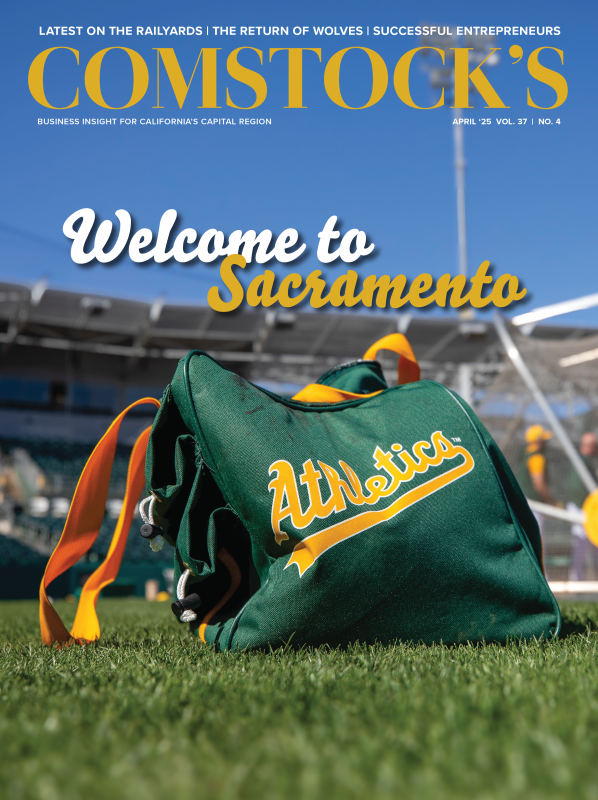The mostly empty Sacramento railyards will come to life this year with construction starting on a stadium, an entertainment center and a hospital. The projects are expected to spur residential development, some of which has already been built.
The Railyards, an urban infill project, promises to transform downtown Sacramento, nearly doubling its existing size. The property consists of 240 acres north of the Amtrak station on H Street and east of Interstate 5.
Before the current developers, two owners held the property, where trains were built and maintained from 1863 to 1993 prior to being sold for redevelopment. Downtown Railyards Ventures, led by the father-son team of Larry and Denton Kelley, brought the kind of experience needed to clean up the old site. In just one of their successes with old industrial sites, they transformed the former McClellan Air Force Base into a thriving business park.
The project has required extensive infrastructure improvements and environmental work. After all the work making the site ready for development, Denton Kelley says it is exciting to see construction finally happening. “You can see the project realizing its vision of an urban entertainment destination,” adds Kelley, who is a member of Comstock’s editorial advisory board.
Downtown Railyards Ventures is developing some of the land, including residential properties and the entertainment center, and selling some of the land to other developers. Kaiser Permanente is building the hospital, and the Wilton Rancheria tribe is building the stadium.
Kaiser broke ground on the new Railyards Medical Center in March. Construction is expected to be complete in 2029. The project on Railyards Boulevard will have an eight-floor, 312-bed hospital, a five-floor office building and other features, city records show.
John Jacobs, vice president of communications for Sacramento Republic FC, says construction will start on the stadium this year and finish in 2027, in time for the soccer club to play there that year. The 12,000-seat stadium will be located in the northeast corner of The Railyards and feature concerts and other events as well.
Construction will start on the entertainment center in the second half of this year and finish in the first quarter of 2027, Kelley says. The entertainment center will be in a redeveloped historic building called the Paint Shop, which is the last in a row of several historic railroad buildings next to one another just north of the Amtrak platform.
In Kelley’s vision for The Railyards, the entertainment center, hospital and stadium will serve as “anchors” for the mixed-use development. A lot of the remaining planned development will be residential, and the anchors will help encourage it, according to Kelley. Kaiser will employ potential residents of The Railyards, he said, and an array of entertainment options, including soccer, concerts and restaurants, will encourage others to live there, too.
The Railyards will emphasize the historical importance of the railroad in Sacramento history.
The significance of the property was magnified with the completion of the transcontinental railroad in 1869 when trains started to replace ships and covered wagons as transportation to and from California, says Ty Smith, director of the California State Railroad Museum. The Railyards served as an assembly line and repair shop for trains on the railroad’s western terminus, Smith adds.
The site was once “the largest and most completely integrated heavy industrial complex west of the Rocky Mountains,” according to a history book of the site, “A Legacy in Brick & Iron.” The authors compare the completion of the transcontinental railroad to the Apollo 11 moon landing.
Two apartment complexes and a state courthouse, in the upper
left-hand corner, have been built in The Railyards, but much of
the land remains empty. Construction of a hospital, entertainment
center and soccer stadium will start this year.

Sacramento’s railyards started to decline when the railroad industry phased out steam trains in the middle of the last century. California State Parks plans to redevelop two of the historic buildings at the railyards into an extension of its popular California State Railroad Museum in Old Sacramento, which is next to The Railyards.
The A.J., the second apartment complex built in The Railyards, is named after 19th-century mechanic A.J. Stevens, known as the “Father of Innovation” at the railyards in the late 1800s. The project is nearing completion.
Just across the railroad tracks, the Wong Center, an affordable housing complex for older adults, was the first housing complex completed in The Railyards. Residents live there now.
A third residential project called The Telegrapher is planned for The Railyards. Construction could start next year, depending on market conditions, Kelley said.
Plans call for as many as 10,000 housing units in The Railyards. Housing makes up the largest part of the general plan for The Railyards, which also includes retail and office space, and parks, among other things.
Sacramento Republic FC Managing Partner Kevin Nagle says the stadium will help kick start more development. “The Railyards will have their own ecosystem, borne out of the stadium being built for (Sacramento Republic FC),” he says. “In time, it will have apartments, condos and homes, coupled with other types of mixed-use development. It will quickly take on a life of its own that spreads far beyond Republic fans.”
The City Council agreed in November to use about $100 million in future expected tax revenue from the project to help pay for infrastructure and land in The Railyards.
“The advancement of these projects will significantly catalyze the redevelopment vision of The Railyards as the city’s most significant infill opportunity,” Michael Jasso, assistant city manager, told the City Council at the time.
Jesus Tarango, chairman of the Wilton Rancheria, which is the majority owner of Sacramento Republic FC, told the council that the tribe feels proud to invest in the stadium.
“We share a strong commitment to the well-being of all the people who call this area home,” he said. “This is more than just a stadium. It is a chance to create jobs, stimulate the economy, invest in community development and share culture.”
Environmental cleanup at The Railyards should be largely complete by the end of the year, according to the state Department of California Department of Toxic Substances Control. The department has oversight of the cleanup efforts, which are carried out by contractors for Union Pacific Railroad and developers of The Railyards. Because people live at The Railyards, the property needs the highest level of cleaning, department officials note.
“We want to make sure it’s safe to live in. We’re working together to make it happen,” says Elizabeth Anne (“Thanne”) Berg, deputy director of the Site Mitigation and Restoration Program at DTSC.
The Central Shops area contains the few remaining historic
buildings in The Railyards. California State Parks hopes to
redevelop the two buildings above as an extension of the popular
California State Railroad Museum in Old Sacramento.

DTSC is encouraging cleanup and redevelopment of “brownfields,” previously developed properties that sometimes are polluted, as a way to address the state’s housing shortage. Brownfields have another development benefit: They’re often located within cities, so building on them reduces development outside of cities, in areas called “greenfields,” which have not been developed. Greenfield development can contribute to suburban sprawl, increases driving and greenhouse gas emissions, which the state is trying to reduce.
Examples of brownfield redevelopment in the Capital Region include McClellan Business Park, which was created on the former U.S. Air Force Base, and Mather, another former Air Force Base converted into an employment hub. Another regional brownfield conversion involves the former Aerojet Rocketdyne rocket-building site, which is being converted into residential property, among other things.
Several large cleanup projects removed some of the hazardous material from soil and groundwater at The Railyards, either by transporting it offsite or treating it on site. Soil remediation is largely complete, DTSC officials say, although some tainted soil remains below protective barriers and some will be cleaned as part of a remaining project.
Groundwater contamination remains as well, state records show and DTSC officials confirm. A polluted groundwater plume stretches across most of The Railyards site and much of the rest of downtown, state records show. Efforts to clean the plume focused on the Central Shops area of The Railyards, where the property’s historical buildings are located, and what was the primary source of the pollutants, DTSC officials said.
DTSC signed off on a plan to clean a second polluted groundwater plume in January. The other remaining remediation project involves cleaning the remains of a former manufactured gas plant, on Jibboom Street, which were discovered in 2003 during another environmental remediation project, state records show. The timeline for the gas plant project is uncertain because it has to be coordinated with an unrelated road project on Jibboom Street.
Property owners will be required to monitor for fumes, as well as provide ventilation systems for indoor areas.
“I have a very high degree of confidence that there won’t be any environmental issues that affect the trajectory of The Railyards’ development or the health of the people using the development,” Kelley says.
Get all the stories in our annual salute to women in leadership delivered to your inbox: Subscribe to the Comstock’s newsletter today.
Recommended For You

The Gray Wolf Was Once Thought to Be Extinct in California. Instead, It Has Made a Remarkable Comeback
Since OR-7, nicknamed Journey, made his fateful crossing, the California wolf population has grown to more than 70 since 2011. However, they remain listed under both the state and federal Endangered Species Act.

Editor’s Addendum: Meeting the Wolves
My visit to the Women for Wolves sanctuary in Placer County was a moving experience
Midway through our interview, we’re interrupted by the most incredible sound: the wolves, howling in harmony with each other. We stop talking and sit silently to take it in. It’s a beautiful, special moment.

A Chapter Ends in Oakland While Another Begins in Sacramento
The Oakland Athletics play an emotional final game at the Coliseum before moving to Sutter Health Park
The Athletics’ final game at the Oakland Coliseum after a championship run of 57 years would be a significant event under any circumstance. But the bittersweet day on Sept. 26 took on an extra dimension for the Capital Region with the A’s scheduled move to West Sacramento.

Sacramento Kings Unveil New Arena Food
Offerings include Thai and Cajun, plus ‘Light the Beam’ themed drinks and desserts
As the Sacramento Kings get ready to kick off the NBA season Thursday night, the chefs at Golden 1 Center have been busy creating new food treats for fans.

Phil Oates Is a Strong Believer in God, Philanthropy, the Sacramento Kings and Candor
At 71, the commercial real estate tycoon continues to earn community-wide kudos — and straight A’s in college
Oates rarely does “the least” he can do. He is chairman of the board of the Buzz Oates Group — a $3 billion commercial real estate investment, management and development firm founded by his late father.

Five Years After the Shelter-in-Place Order, How Is Downtown Sacramento Doing?
Sacramento businesses face mixed results since first shutdowns associated with COVID-19 pandemic in March 2020
In the first year of the COVID-19 pandemic, Comstock’s followed four downtown Sacramento businesses and their broader sectors for a six-part series. On the fifth anniversary of the shutdowns, we checked in to see how they are faring.




